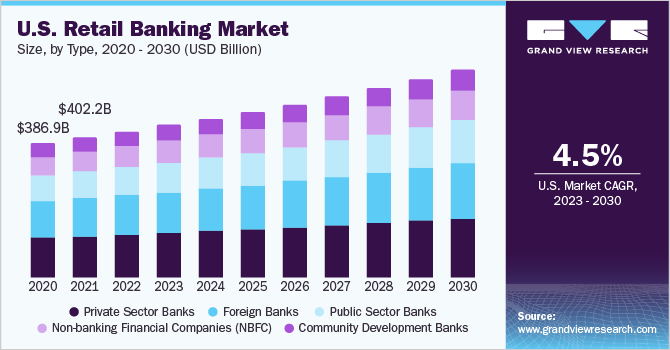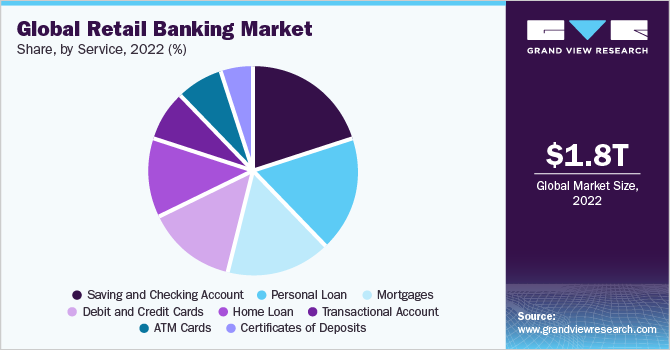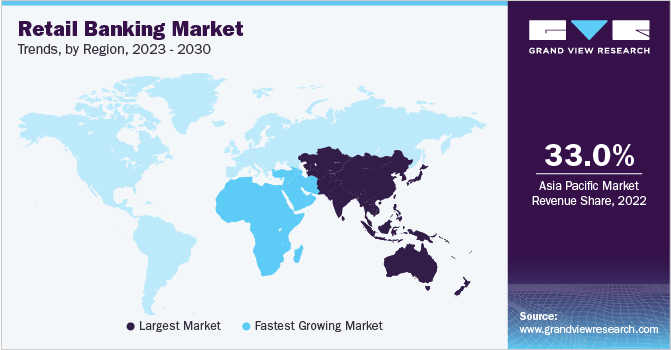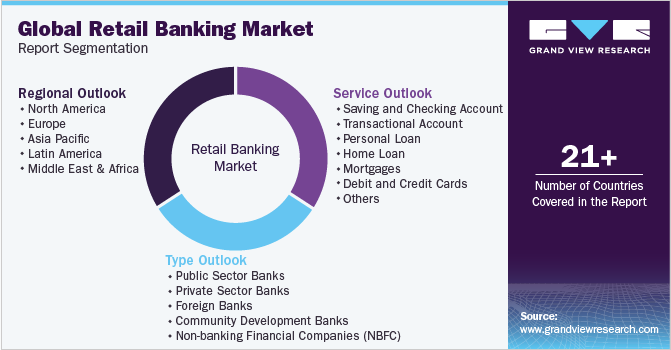- Home
- »
- Next Generation Technologies
- »
-
Retail Banking Market Size, Share & Trends Report, 2030GVR Report cover
![Retail Banking Market Size, Share & Trends Report]()
Retail Banking Market Size, Share & Trends Analysis Report By Type (Public Sector Banks, Private Sector Banks, Foreign Banks), By Service (Saving & Checking Accounts, Credit & Debit Cards), By Region, And Segment Forecasts, 2023 - 2030
- Report ID: GVR-4-68040-074-4
- Number of Report Pages: 110
- Format: PDF, Horizon Databook
- Historical Range: 2017 - 2021
- Forecast Period: 2023 - 2030
- Industry: Technology
Retail Banking Market Size & Trends
The global retail banking market size was valued at USD 1,840.77 billion in 2022 and is expected to grow at a compound annual growth rate (CAGR) of 5.6% from 2023 to 2030. The growth is driven by rapid technological advancements shaping the market’s dynamics and growth potential. The progress in digital technologies has transformed the way customers interact with banks. The rise of online and mobile banking has made banking services more accessible and convenient for customers, allowing them to conduct transactions, check balances, and access a wide range of services at their fingertips.

Another significant driver is changing customer expectations. Customers nowadays expect personalized and tailored banking experiences. They demand seamless integration across various channels, including online, mobile, and physical branches. Banks that can adapt and provide a superior customer experience through personalized services, innovative products, and efficient processes are likely to thrive in the competitive market. Moreover, demographic shifts are impacting the retail banking market. The growing middle class in emerging economies creates new opportunities for banks to create customer’s banking requirements.
In addition, competition within the retail banking sector is intensifying. Traditional banks face competition from fintech startups and technology players entering the financial services space. These new players leverage technological innovations, such as deep learning and blockchain, to offer disruptive products and services. Traditional banks are focusing on embracing digital transformation, collaborating with fintech firms, or developing innovative solutions to stay competitive.
Regulatory changes also play a crucial role in shaping the retail banking landscape. Governments and regulatory bodies worldwide impose strict regulations to enhance consumer protection, ensure financial stability, and promote fair practices in the banking industry. Compliance with these regulations requires banks to invest in robust risk management systems, data protection measures, and regulatory reporting capabilities. Moreover, transparency, security, and ethical practices can gain a competitive advantage for the market players, and foster long-term customer relationships, driving the market further.
However, the market growth is obstructed by the threat of increasing cybersecurity risks. As digitalization expands, banks face a growing number of cyber threats, including data breaches, identity theft, and fraudulent activities. These risks not only harm the customers but also damage the reputation of the banks. To overcome this challenge, banks need to prioritize cybersecurity measures and invest in robust systems to protect customer data. Implementing multi-factor authentication, encryption techniques, and continuous monitoring can help mitigate risks.
COVID-19 Impact Analysis
The COVID-19 pandemic has had a positive impact on the growth of the retail banking market. With lockdowns and social distancing measures in place, people turned to digital channels for their banking needs more than ever before. This accelerated the adoption of online and mobile banking services, leading to increased digital transactions, account openings, and usage of digital payment solutions. The pandemic served as a catalyst for banks to enhance their digital capabilities and invest in innovative technologies to meet the surge in demand.
Type Insights
The private sector banks segment dominated the market in 2022 and accounted for a revenue share of more than 29.0%. The private sector banks have leveraged their agility and flexibility to adapt to changing market conditions and customer preferences. Unlike public sector banks, they are not burdened by bureaucratic processes and enjoy greater autonomy in decision-making, enabling them to respond swiftly to market demands and introduce innovative products and services.
Moreover, private sector banks have been successful in creating a customer-centric approach. They prioritize delivering a superior customer experience by offering personalized services, convenient banking channels, and quick turnaround times.
The public sector banks segment is anticipated to register significant growth over the forecast period. The public sector banks enjoy a vast network and presence across various regions, including rural and semi-urban areas. This extensive branch network enables them to tap into a large customer base and reach underserved markets, contributing to their growth.
Moreover, public sector banks often prioritize financial inclusion and social objectives. They are committed to serving the unbanked and underprivileged sections of society, promoting inclusive banking practices. By offering affordable and accessible banking services, such as basic savings accounts and government welfare schemes, public sector banks are expanding their customer base and deepening their penetration in previously untapped segments.
Service Insights
The saving and checking account segment dominated the market in 2022 and accounted for a revenue share of more than 20.0%. Saving and checking accounts are the foundation of personal banking. They provide customers with a secure place to deposit and manage their funds, making them essential for everyday financial transactions and savings goals.

As a result, the demand for saving and checking accounts remains consistently high among individuals and businesses. Moreover, saving and checking accounts offer liquidity and accessibility. Customers can easily deposit and withdraw funds as needed, making them highly convenient for day-to-day financial activities. The ability to access funds through ATMs, online banking, and mobile apps has further enhanced the appeal and popularity of these accounts.
The debit and credit cards segment is anticipated to register the fastest growth over the forecast period. Debit and credit cards offer convenience and flexibility in making transactions. They eliminate the need for carrying cash, allowing customers to make purchases easily and securely. The widespread acceptance of debit and credit cards by merchants and the integration of contactless payment technology have further propelled the growth of this segment.
Moreover, debit and credit cards provide users with various benefits and rewards programs. Banks offer cashback, loyalty points, airline miles, and other incentives to encourage card usage. These rewards attract customers and incentivize them to choose cards as their preferred payment method, driving the growth of this segment.
Regional Insights
Asia Pacific dominated the retail banking market in 2022 and accounted for a revenue share of more than 33.0%. The region has a large and rapidly growing population, with a rising middle class and increasing disposable income. This demographic trend has led to a higher demand for banking services, including savings accounts, loans, and investment products.

Moreover, the region has experienced significant economic growth and urbanization, leading to the expansion of businesses and increased financial activity. As a result, there is a greater need for banking services to support commercial and personal transactions.
Middle East & Africa is expected to emerge as the fastest-growing market over the forecast period. The region has a large and rapidly expanding population, with a significant portion of the population being young and tech-savvy. This demographic dividend presents a tremendous growth opportunity for retail banking, as these individuals seek convenient and accessible banking solutions to meet their financial needs.
Moreover, there is a growing emphasis on financial inclusion in the MEA region. Governments and regulatory authorities are actively promoting initiatives to improve access to banking services for underserved populations, including those in rural areas and low-income segments. This focus on financial inclusion is driving the adoption of retail banking and contributing to the region's rapid growth.
Key Companies & Market Share Insights
In the competitive landscape of the retail banking industry, various players employ different strategies to gain market share and establish a competitive edge. Traditional banks strive to enhance their digital capabilities and customer-centric approach. They invest in technology infrastructure, develop user-friendly mobile apps and online platforms, and offer personalized services to provide a seamless and convenient banking experience. By adapting to changing customer preferences and embracing digital transformation, traditional banks aim to retain existing customers and attract new ones.
In addition, strategic partnerships and collaborations play a crucial role in gaining market share. Banks form alliances with fintech startups, big tech companies, or other financial institutions to leverage complementary strengths and expand their service offerings. For instance, in April 2023, Regions Bank, a bank based in the U.S., partnered with Temenos to upgrade and modernize its core banking services. Regions Bank aims to enhance its customer experiences and provide personalized banking products and services through this collaboration. The partnership will play a crucial role in assisting individuals and businesses in accomplishing their financial objectives. Some prominent players in the global retail banking market include:
-
BNP Paribas
-
Citigroup, Inc.
-
HSBC Group
-
ICBC
-
JP Morgan Chase & Co.
-
Bank of America Corporation
-
Barclays
-
China Construction Bank
-
Deutsche Bank AG
-
Mitsubishi UFJ Financial Group, Inc.
-
Wells Fargo
Retail Banking Market Report Scope
Report Attribute
Details
Market size value in 2023
USD 1,936.23 billion
Revenue forecast in 2030
USD 2,840.70 billion
Growth rate
CAGR of 5.6% from 2023 to 2030
Base year of estimation
2022
Historical data
2017 - 2021
Forecast period
2023 - 2030
Quantitative units
Revenue in USD billion and CAGR from 2023 to 2030
Report coverage
Revenue forecast, company market share, competitive landscape, growth factors, and trends
Segments covered
Type, service, region
Regional scope
North America; Europe; Asia Pacific; Latin America; MEA
Country scope
U.S.; Canada; UK; Germany; France; Italy; China; Japan; India; South Korea; Australia; Brazil; Mexico; Kingdom of Saudi Arabia (KSA); UAE; South Africa
Key companies profiled
BNP Paribas; Citigroup, Inc.; HSBC Group; ICBC; JP Morgan Chase & Co.; Bank of America Corporation; Barclays; China Construction Bank; Deutsche Bank AG, Mitsubishi UFJ Financial Group, Inc., Wells Fargo
Customization scope
Free report customization (equivalent to up to 8 analysts working days) with purchase. Addition or alteration to country, regional & segment scope
Pricing and purchase options
Avail customized purchase options to meet your exact research needs. Explore purchase options
Global Retail Banking Market Report Segmentation
The report forecasts revenue growth at global, regional, and country levels and provides an analysis of the latest industry trends in each of the sub-segments from 2017 to 2030. For the purpose of this study, Grand View Research has segmented the retail banking market report based on type, service, and region.

-
Type Outlook (Revenue, USD Billion, 2017 - 2030)
-
Public Sector Banks
-
Private Sector Banks
-
Foreign Banks
-
Community Development Banks
-
Non-banking Financial Companies (NBFC)
-
-
Service Outlook (Revenue, USD Billion, 2017 - 2030)
-
Saving and Checking Account
-
Transactional Account
-
Personal Loan
-
Home Loan
-
Mortgages
-
Debit and Credit Cards
-
ATM Cards
-
Certificates of Deposits
-
-
Regional Outlook (Revenue, USD Billion, 2017 - 2030)
-
North America
-
U.S.
-
Canada
-
-
Europe
-
UK
-
Germany
-
France
- Italy
-
-
Asia Pacific
-
China
-
Japan
-
India
-
South Korea
-
Australia
-
-
Latin America
-
Brazil
-
Mexico
-
-
Middle East & Africa
-
Kingdom of Saudi Arabia (KSA)
-
UAE
-
South Africa
-
-
Frequently Asked Questions About This Report
b. The global retail banking market size was estimated at USD 1,840.77 billion in 2022 and is expected to reach USD 1,936.23 billion in 2023.
b. The global retail banking market is expected to grow at a compound annual growth rate of 5.6% from 2023 to 2030 to reach USD 2,840.70 billion by 2030.
b. Asia Pacific dominated the retail banking market with a share of 33.15% in 2022. The region has a large and rapidly growing population, with a rising middle class and increasing disposable income. This demographic trend has led to a higher demand for banking services, including savings accounts, loans, and investment products.
b. Some key players operating in the retail banking market include BNP Paribas; Citigroup, Inc.; HSBC Group; ICBC; JP Morgan Chase & Co.; Bank of America Corporation; Barclays; China Construction Bank; Deutsche Bank AG, Mitsubishi UFJ Financial Group, Inc., and Wells Fargo.
b. Key factors that are driving the retail banking market growth include rapid technological advancements and evolving customer expectations.
Share this report with your colleague or friend.
![gvr icn]()
NEED A CUSTOM REPORT?
We can customize every report - free of charge - including purchasing stand-alone sections or country-level reports, as well as offer affordable discounts for start-ups & universities. Contact us now
![Certified Icon]()
We are GDPR and CCPA compliant! Your transaction & personal information is safe and secure. For more details, please read our privacy policy.
We are committed towards customer satisfaction, and quality service.
"The quality of research they have done for us has been excellent."





